Upland Habitat

Because recharge activities only occur on about a third of the water bank property, upland habitat is being re-established on much of the remaining Water Bank acreage that was once farmed. Adaptive vegetation management programs have focused on regenerating native grasses and plants, and threatened and endangered species unique to Kern County, such as Tipton kangaroo rats, burrowing owls, and tricolored blackbirds are re-emerging. Also, raptors, kangaroo rats, pocket mice, rabbits, American badgers, bobcats and coyotes now co-exist on the land.
With water conservation and habitat preservation as dual goals, the Kern Water Bank Authority, United States Fish and Wildlife Service, and California Department of Fish and Game executed the Kern Water Bank Habitat Conservation Plan/Natural Community Conservation Plan (HCP/NCCP) in 1997. The HCP/NCCP created a blueprint for accomplishing both goals.
The primary environmental objectives of the HCP/NCCP are to set aside large portions of the water bank land for threatened and endangered species and create a program that protects and enhances both intermittent wetland and upland habitat areas. Other provisions were made to protect sensitive native habitat in special areas throughout the property.
Each year, the Kern Water Bank Authority submits an annual report and management plan addressing operations, land management, and monitoring activities to the US Fish and Wildlife Service and the California Department of Fish and Game.
After more than a decade in place, the HCP/NCCP has seen many successes on the property, including a noticeable increase in the habitat value for both the upland species found on the property and for waterfowl species that have not been seen in the area for more than 70 years.
These accomplishments have been achieved through adaptive management in conjunction with the primary goal of recharging water.
